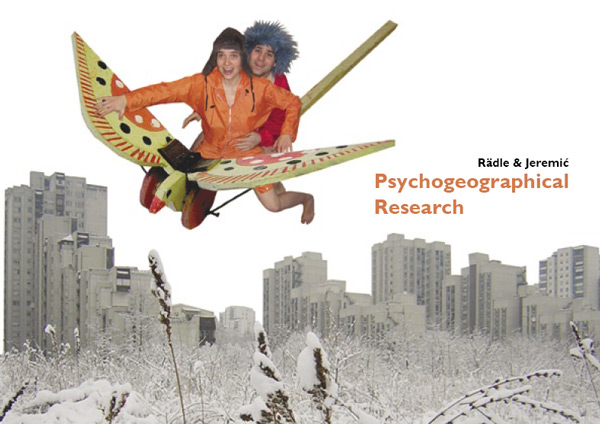the book can be downloaded as pdf here

Introduction
This is a record about the research we were doing together over the last years in Serbia and Germany. Our explorations are documented in photos, video recordings and scripts, of which some can be seen on these pages. We use the term psychogeographical research, because we explore the relations between us and the environment, testing possibilities to act in the geo- or “outer” world, be it manifested in landscape, architecture or social and cultural structures.
There exists a quasi-consensus about a world that is constructed by cultural determinations as gender, nationality, religion, education, discourses and social positions. This “reality” forces us to identify ourselves with certain categories that function as units in a system of power. It is based on the dualism of exclusion and inclusion and only representing a certain identity we can reach an active position within this construction (for example claiming the rights of a particular group). Doing so, we in fact reproduce the essential mechanism of power and multiply conflicts.
In our practice we try to develop a subject that is not based on identity and therefore is not bound to repetitive behaviour. This subject is a temporary expression of relations (that we might partly be able to follow) and doesn’t represent any discipline of the society. It has no shape but is created through immediate interaction with other people and in direct touch with the environment. It grows out of encounters or situations that are not mediated, not expected and not exposed on the public stage.
In the studies/exercises we call psychogeographical research we create this subject through transgression of identity. Therefore we invent fi ctional characters that act in real situations. They equip themselves with things that function as imaginary tools to communicate with the “world” or invent stories that connect them to the life of other people. Being these imaginary characters we spontaneously interact with persons, situations and things in a state of complete presence, trying to forget what we know and what we want. In this direct, non-mediated and unexpected interaction the imaginary subject and its actions become real.
Rena and Vladan
4 Phenomena of Transfer
website
6 Drugarica and Gastarbeiter
Drugarica, video, 2002, 6 min
download mpg: 55 MB
Gastarbaiter, video, 2003, 6 min
download mpg: 55 MB
7 Horrorkatze Eating Grass
website
8 Horrorkatze macht Terror
website,
"Potsdamer Reloaded", video, 2003, 5 min
view video
download mpg: 60 MB
10 Bottle of Sand
website
12 Fruška Gora
view video
14 SENDI
website, video, 2003, 10 min,
download mpg: 80 MB
16 Novi život
book, 40 pages, 2006
download pdf: 2,4 MB
18 Under the Bridge
book, 80 pages, 2005
download pdf: 2 MB